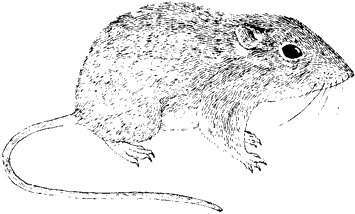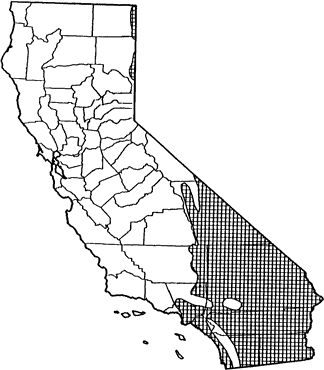
Little Pocket Mouse
Distribution, Abundance, and Seasonality
The little pocket mouse is a common to abundant yearlong resident of the southern deserts. Range extends northward into southeastern Mono, Tulare, and Kern cos. It also is found on the Northeastern Plateau in eastern Modoc and Lassen cos., and in the Los Angeles Basin south through coastal areas to Mexico. Preferred habitats include desert riparian, desert scrub, desert wash, coastal scrub, and sagebrush. Elevations range from sea level to 1700 m (5600 ft).

Range Map
Specific Habitat Requirements
Feeding: Predominantly granivorous. Green vegetation of grasses, forbs, or shrubs is consumed in spring (Bradley and Mauer 1973). In coastal scrub, grass seeds are eaten in summer, fall, and winter, and forb seeds are eaten in spring (Meserve 1976b). Cheek pouches of pocket mice in Nevada contained seeds of Franseria, Plantago, Festuca, Eriogonum, and Chenopodium (Burt 1934, Hall 1946). Searches for seeds mainly beneath shrub canopy (Brown and Lieberman 1973).
Cover: Sandy soil preferred for burrowing (Hall 1946), but also found commonly on gravel washes and on stony soils (Beatley 1976b, Miller and Stebbins 1964). The burrows are plugged during the day.
Reproduction: Nest made of green leaves and dry roots, usually beneath shrubs. A burrow system excavated by Kenagy (1973a) had runway diameters of 1.5 to 2.0 cm (0.6 to 0.8 in). The nest chambers, 8 cm (3.2 in) wide by 5 cm (2.0 in) high, were found 52 and 65 cm (1.7 and 2.1 ft) beneath the surface.
Water: Obtains water from food.
Pattern: Rarely found on rocky sites. Occurs in virtually all canopy coverage classes in most desert habitats.
Species Life History
Activity Patterns: Nocturnal. Peak activity tends to occur early in the night (Kenagy 1973a). Enters torpor under conditions of food-stress or low temperature (Bartholomew and Cade 1957, Chew and Butterworth 1964). Inactive above ground from fall to spring, depend- ing on food reserves and minimum nightly temperature (Chew and Butterworth 1964, Bradley and Mauer 1973, Kenagy 1973a).
Seasonal Movements / Migration: None.
Home Range: In Joshua Tree National Monument, home ranges were 0.12 to 0.56 ha (0.30 to 1.4 ac) (Chew and Butterworth 1964). In Nevada, male home ranges averaged 0.29 to 1.88 ha (0.7 to 4.7 ac) and female ranges averaged 0.48 to 3.09 ha (1.2 to 7.6 ac) (Maza et al. 1973). Maximum densities of 1.7/ha (0.7/ac) in creosote scrub (Chew and Butterworth 1964). Populations fluctuated from 1-5.5 individuals per ha (0.4-2.2 per ac) (Chew and Butterworth 1964, French et al. 1974).
Territory: No additional data found.
Reproduction: Breeds from January to August with peak from March to May (timing depends on temperatures, food supply, and timing of spring plant growth). Gestation 21 -31 days (Hayden et al. 1966). Litter size ranges from 2-8 with an average of 4.3; usually only 1 litter per yr (Hall 1946). Age at weaning 30 days (Hayden et al. 1966). Females can breed at 50 days, males at 150 days (Hayden et al. 1966).
Niche: Very small-bodied granivore, well-adapted for desert life. Predators include snakes, owls, and predatory mammals, including grasshopper mice. Sympatric with a large number of other rodent species.
Comments: P. I. brevinasus of the Los Angeles Basin and P. I. pacificus of the southern coastal plains have declined markedly in numbers from severe and continuing loss of habitat.
Sources & References
California Department of Fish and Game, 1999.
California's Wildlife, Sacramento, CA.
Written by: P. Brylski, reviewed by: H. Shellhammer, edited by: R. Duke
Bartholomew, G. A., and T. J. Cade. 1957. Temperature regulation, hibernation, and estivation in the little pocket mouse, Perognathus longimembris. J. Mammal. 38:60-72.
Beatley, J. C. 1976b. Rainfall and fluctuating plant populations in relation to distributions and numbers of desert rodents in southern Nevada. Oecologia (Berlin) 24:21-42. Bradley, W. G., and R. A. Mauer. 1973. Rodents of a creosote-bush community in southern Nevada. Southwest. Nat. 17:333-344.
Brown, J. H., and G. A. Lieberman. 1973. Resources utilization and coexistence of seed eating desert rodents in sand dune habitats. Ecology 54:788-797.
Burt, W. H. 1934. The mammals of southern Nevada. Trans. San Diego Soc. Nat. Hist. 7:375-427. Chew, R. M., and B. B. Butterworth. 1964. Ecology of rodents in Indian Cove (Mojave Desert), Joshua Tree National Monument, California. J. Mammal. 45:203-225. French, N. R., B. G. Maza, H. U. Hill, A. P. Aschwanden, and H. W. Kaaz. 1974. A population study of irradiated desert rodents. Ecol. Monogr. 44:45-72. Hall, E. R. 1946. Mammals of Nevada. Univ. California Press, Berkeley. 710pp. Hayden, P., J. J. Gambino, and R. G. Lindberg. 1966. Laboratory breeding of the little pocket mouse, Perognathus longimembris. J. Mammal. 47:412-423.
Kenagy, G. J. 1973a. Daily and seasonal patterns of activity and energetics in a heteromyid rodent community. Ecology 54:1201-1219.
Maza, B. G., N. R. French, and A. P. Aschwanden. 1973. Home range dynamics in a population of heteromyid rodents. J. Mammal. 54:405-425.
Meserve, P. L. 1976b. Food relationships of a rodent fauna in a California coastal sage scrub community. J. Mammal. 57:300-319.
Miller, A. H., and R. C. Stebbins. 1964. The lives of desert animals in Joshua Tree National Monument. Univ. California Press, Berkeley. 452pp. Wilken, K. K., and R. Ostwald. 1968. Partial contact as a stimulus to laboratory mating in the desert pocket mouse, Perognathus penicillatus. J. Mammal. 49:570-572. Williams, D. F. 1986. Mammalian species of special concern in California. Calif. Dept. Fish and Game, Sacramento. Admin. Rep. 86-1. 112pp.
California Animal Facts | California's Wildlife